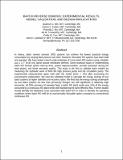BATCH REVERSE OSMOSIS: EXPERIMENTAL RESULTS, MODEL VALIDATION, AND DESIGN IMPLICATIONS
Author(s)
Wei, Quantum J.; Tucker, Carson I.; Wu, Priscilla J.; Trueworthy, Ali M.; Tow, Emily W.; Lienhard, John H; ... Show more Show less
DownloadWEI-paperMTC-final.pdf (987.2Kb)
PUBLISHER_CC
Publisher with Creative Commons License
Creative Commons Attribution
Terms of use
Metadata
Show full item recordAbstract
In theory, batch reverse osmosis (RO) systems can achieve the lowest practical energy consumption by varying feed pressure over time. However, few batch RO syste ms have been built and operated. We have tested a bench-scale prototype of a true batch RO system using a bladder and a 2.5” (6.35 cm) spiral wound membrane element. Some practical issues in implementing batch RO include system start-up time, system depressurization, osmotic backwash during the reset phases, and lower permeate quality. This study is the first to validate batch models by measuring the hydraulic work of both the high pressure pump and the circulation pump. The experimental measurements agree well with the model (error ≤ 3 %) after accounting for concentration polarization. We used the validated model to calculate the energy savings of true batch systems at higher salinities and recovery ratios. We find that the energy savings achievable by true batch systems are less than previously thought, but still significant at relatively high recoveries. At 50% recovery of seawater feed, a batch RO plant could save 15% of the energy consumed by a continuous RO plant while still maintaining the same effective flux. Further studies should identify the additional costs associated with batch RO in order to identify the operating conditions where batch RO will be an economically favorable option compared to conventional continuous RO.
Date issued
2019-02Department
Massachusetts Institute of Technology. Department of Electrical Engineering and Computer Science; Massachusetts Institute of Technology. Department of Mechanical EngineeringJournal
2019 AMTA/AWWA Membrane Technology Conference & Exposition
Publisher
American Membrane Technology Association
Citation
Wei, Quantum J. et al. "Batch reverse osmosis: experimental results, model validation and design implications." 2019
AMTA/AWWA Membrane Technology Conference & Exposition, February 2019, New Orleans, Louisiana, American Membrane Technology Association, February 2019.
Version: Final published version